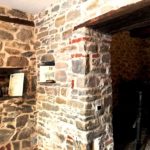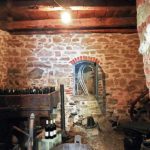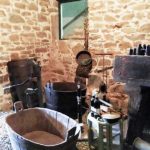Abbiamo una storia da raccontarvi. È la storia dell’infernot collocato nella nostra casa dove ha sede l’Azienda Agricola Barberis. Perché vogliamo condividerla con voi? Perché desideriamo farvi partecipi, tra una degustazione e una visita, di quel passato che ci ha condotti fin qua e che ci rende, da sempre, fedeli custodi del tempo.
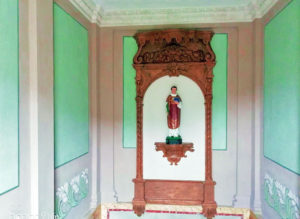 Tutto ebbe inizio negli anni ’30 quando Emilio, padre di Bruno, attuale titolare dell’attività, acquistò Cascina San Lorenzo da una facoltosa signora del luogo. L’ex proprietaria era così devota al Santo da intitolargli l’abitazione e omaggiarlo di una statua, tuttora visibile all’interno di una nicchia lungo le scale interne che conducono ai piani superiori. Ma fu durante il decennio successivo, che la casa (o, meglio, il suo infernot) dovette affrontare il suo periodo più buio.
Tutto ebbe inizio negli anni ’30 quando Emilio, padre di Bruno, attuale titolare dell’attività, acquistò Cascina San Lorenzo da una facoltosa signora del luogo. L’ex proprietaria era così devota al Santo da intitolargli l’abitazione e omaggiarlo di una statua, tuttora visibile all’interno di una nicchia lungo le scale interne che conducono ai piani superiori. Ma fu durante il decennio successivo, che la casa (o, meglio, il suo infernot) dovette affrontare il suo periodo più buio.
Proprio dietro la stanza del punto vendita che accoglie i visitatori, si trova un’apertura che conduce in un infernot di mattoni a vista. Oggi, è un angolo suggestivo dove vibrano riflessi di pregiate bottiglie e si intuiscono le sagome degli attrezzi antichi; ma nel periodo della Seconda Guerra Mondiale, era il luogo dove Emilio e suo fratello si nascondevano dai tedeschi che setacciavano la valle in cerca di nemici e disertori. C’era un tino, a celarne l’ingresso. I familiari portavano loro il cibo e, non di rado, accadeva che i due uomini fossero costretti a trascorrere diversi giorni chiusi lì dentro, vittime dell’attesa e delle possibili perquisizioni naziste.
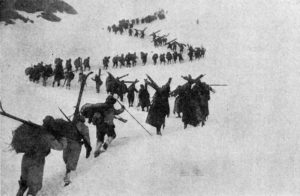 Sì, erano disertori. Avevano combattuto la campagna di Russia. E dopo la ritirata delle forze dell’Asse, erano ritornati a piedi in Italia, percorrendo oltre 2.500 chilometri, molti dei quali lungo la gelida e desolata steppa, a 40 gradi sotto zero. Scampati ai treni dei lager in partenza da Bolzano e approfittando di alcuni passaggi di fortuna, varcarono finalmente la soglia di casa, con lo stupore dei famigliari che li temevano per sempre dispersi. Era il 1944.
Sì, erano disertori. Avevano combattuto la campagna di Russia. E dopo la ritirata delle forze dell’Asse, erano ritornati a piedi in Italia, percorrendo oltre 2.500 chilometri, molti dei quali lungo la gelida e desolata steppa, a 40 gradi sotto zero. Scampati ai treni dei lager in partenza da Bolzano e approfittando di alcuni passaggi di fortuna, varcarono finalmente la soglia di casa, con lo stupore dei famigliari che li temevano per sempre dispersi. Era il 1944.
Dal 2016, l’azienda è passata ai figli di Bruno, Cristina e Stefano. Se ci verrete a trovare, saremo felici di raccontarvi questa storia di persona, magari dietro a un buon calice di Barbera, mostrandovi gli oggetti del nostro passato, come il piccolo torchio per fare l’olio di nocciole in tempo di guerra, e facendovi respirare quell’aria di famiglia che ha perdurato nei decenni, giungendo intatta fino ad oggi.
We have a story to tell you. It is the story of the infernot of our house where the Barberis Farm is located. Why do we want to share it with you? Because we would like to involved you, between a tasting and a visit, of the past that has led us here and that makes us, as always, faithful custodians of time.
All began in the 1930s when Emilio, Bruno’s father, current owner of the business, bought Cascina San Lorenzo from a wealthy local lady. The ex former owner was so devoted to the Santo to name the house and pay homage to a statue, still visible inside a niche along the internal stairs leading to the upper floors. But it was during the next decade that the house (or, better, its infernot)had to face its darkest period.
Just behind the room that welcomes the visitors, there is an opening that leads into an infernot of exposed brick. Today, it is a charming corner where reflections of fine bottles vibrate and the outlines of ancient tools are sensed; but in the period of the Second World War, it was the place where Emilio and his brother hid from the Germans who searched the enemies and deserters. There was a vat, to conceal the entrance. The family members brought them food and, not infrequently, it happened that the two men were forced to spend several days locked up there, victims of waiting and possible Nazi searches.
Yes, they were deserters. They had fought the Russian campaign. And after the withdrawal of the Axis forces, they had returned by foot to Italy, covering over 2.500 kilometers, many of them along the icy and desolate steppe, at 40 degrees below zero. Escaped from the lager trains leaving from Bolzano and taking advantage of some rides of luck, they finally crossed the threshold of the house, to the amazement of the family who thougth they had died. It was 1944.
Since 2016, the company has passed to the sons of Bruno, Cristina and Stefano. If you come to visit us, we will be happy to tell you this story, behind a good glass of Barbera, showing you the objects of our past, like the small press to make hazelnut oil in wartime, and letting you breathe that family air during over the decades, reaching intact until today.


